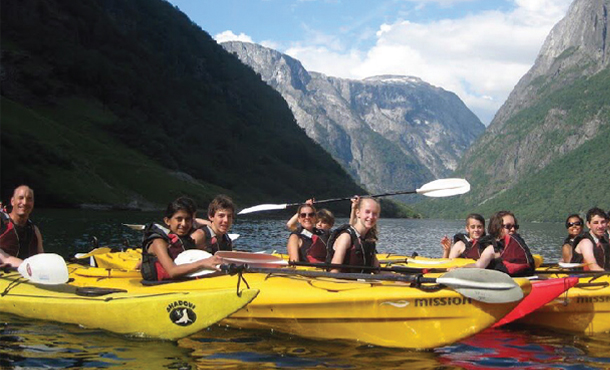
Taking Learning Outside the Classroom
Students Travel the Country and World to Put Lessons Into Action
By Cady Schulman
Sometimes education goes beyond the classroom. Learning doesn’t have to be limited to books and lectures. Teachers can also rely on real-world experiences to engage students and give them a first-hand look at what is going on beyond the four walls of the classroom.
Connecting to the world is a vital part of education, says Jason Underwood, head of school at High Meadows School in Roswell. It sparks curiosity and joy in students, which means they pay more attention when they are in class. “We’ve noticed that our kids really are successful academically and socially as a result of getting outside of the classroom and getting outside of themselves,” Underwood says.
Learning Beyond the Desk
Going outside the classroom might be as simple as a trip to the Atlanta Zoo or the High Museum of Art, both of which offer activities that are geared to each grade level. Visiting the Atlanta Botanical Gardens’ Rainforest Conservatory could add sensory experiences to the concepts in a geography chapter.
In the local community, across the country and around the globe, students can learn more about the outside world—up close and personal. The result is students who are better citizens and more eager to learn.
“(Our) kids spend a good deal of time outdoors,” says Underwood of High Meadows School. “We certainly believe in kids playing on their own. We believe it’s absolutely imperative for kids to have that freedom and free play to support them academically. They need to be inspired and have a context of learning that’s well beyond the desk.”
In fact, at High Meadows School, the outdoors are viewed as another teacher. On a campus that includes more than 40 acres of farm and woodland, nature is an extension of the school’s classrooms. Students perform environmental studies of ponds and wooded areas, middle school students take an outdoor living skills class as an elective, and students create environmental art, learning how to use natural materials to create art rather than canvas or molding clay. There are also a variety of animals on campus—including bunnies, chickens, goats and sheep—and the students are able to help care for them.
In addition to outdoor learning programs, the school also partners with the city’s STAR House Foundation to allow students to work with at-risk children and learn first-hand about poverty and how they can help with the needs in the local community.
Traveling the World for Environmental Studies
Journeying outside the classroom may involve a local field trip—or it could be a trip to a distant locale. Pace Academy’s Isdell Center for Global Leadership focuses on one global theme each year and takes more than 200 students to various global locations. This year’s climate theme will take upper school students from the Buckhead school to several unique locations. Traveling to South Africa, Alaska, and New Zealand, they will see how global warming affects various environments and cultures.
“It’s bringing forward an experience, allowing kids to experience the world,” says Tricia Anderson, director of the Isdell Center for Global Leadership. “No teacher can possibly give them that alone. We can supplement that experience and give them academic focus, but [travel enables them to] experience sitting with people who live it and are in it and doing research with scientists.”
Meanwhile, some trip choices at Pace Academy for middle schoolers include Australia to study the acidification of the ocean and its impact on the great barrier reef, and Kenya to promote HIV and AIDS awareness and to look at sustainable agriculture for people affected by the disease. Again, experiences add to learning.
Four Pace students who went through an intense selection process will spend 12 days in Churchill, Manitoba, working with scientists at the Northern Arctic Study Center to study the ecosystems of polar bears and environmental issues related to vegetation.
“When they’re in the field, they see these subject areas come to life, and they finally get it,” says Anderson.
Partnerships at Home and Abroad
Taking education outside the classroom is part of a broader trend among educators to make the lessons students learn more relevant to the real world.
“Education is moving away from memorization and rote things,” says Angela Morris-Long, director of civic engagement at The Lovett School in North Atlanta. “We’re moving into solving real world issues and application of that. [We’re] trying to teach kids about the world they live in and take it out of the classroom. I think we all have to be doing a better job of that. The world is an ever-changing place.”
For the last 24 years, The Lovett School has partnered with Habitat for Humanity to give its students the chance to learn necessary life skills while helping build homes for people in need. This year, the students will build a house on-campus to enable students under the age of 16 to participate as well.
Two years ago, the school took its partnership with Habitat a step further by traveling to Romania to build houses for orphans nearing age 18, the age at which they can no longer live in orphanages. The students saw poverty and the problem of readily available affordable housing first-hand during their 10-day trip.
The school also has taken students to Ecuador to study tropical ecology and has held a two-week program during which students spent time away from school learning about poverty right here in the metro Atlanta area.
Engaging Students Outside the Classroom
Keeping the attention of students is an ongoing challenge in any education environment. Classrooms, books and lectures are important tools for teachers, but hands-on experiences outside the school building are also important ways to engage students.